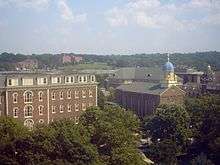University of Dayton School of Law
| University of Dayton School of Law | |
|---|---|
|
| |
| Established | 1922 |
| School type | Private |
| Dean | Andrew L. Strauss |
| Location | Dayton, Ohio, United States |
| Enrollment | 300 |
| Website | Dayton Law home |
The University of Dayton School of Law (UDSL) is a private law school located in Dayton, Ohio. It is affiliated with the University of Dayton, which is a Catholic university of the Society of Mary. The school is accredited by the American Bar Association and is a member of the Association of American Law Schools.[1][2]
The school's Class of 2016 is made up of students from across the country with 45% coming from places other than Ohio.[3]
History
The School of Law was first established as the University of Dayton College of Law in 1922 under the guidance of Dean John C. Shea, the former first assistant director of law for Dayton.[4] The college’s first class included two women and one African American. Economic issues during the Great Depression led the law school to close its doors in 1935.[4]
The law school reopened in September 1974 under its current name.[4] In July 1997, the school's current location, Joseph E. Keller Hall, was opened.[5]
Curriculum
Two-year J.D. Program
The school offers its students the option of pursuing a J.D. at an accelerated pace. Students may earn a law degree in two years by beginning in May and going to school full-time including summer terms.[6]
Hybrid J.D.
Through a hybrid J.D. program called Law@Dayton, students will be able to take most of their classes online, coming to campus for only a week each semester.[7] The program will start in 2019.[7]
Program In Law And Technology (PILT)
In 1989, the law school created the Program in Law and Technology (PILT), one of the first programs of its kind in the country. PILT offers courses in patent law, copyright and trademark law, business dimensions of intellectual property law, cyberspace law, entertainment law and the impact of technology on the practice of law.[8] Collaborations with Emerson and LexisNexis provide hands-on experience in areas of data security and privacy, product liability, regulation and developing new legal products and services.[9]
Human Rights Collaborative
Through a partnership with the University of Dayton's Human Rights Center, law school students and faculty can work to protect the rights of vulnerable citizens across the world. The collaborative features a course on human rights and joint-research projects between the law school and the center.[10]
Concentrations
The law school offers students the ability to take concentrations in six different areas: Business Law & Compliance, Civil Advocacy & Dispute Resolution, Criminal Law, Human & Civil Rights Law, Law & Technology and Personal & Family Law. The concentrations allow students to develop their skills and knowledge in those specific areas in an effort to give them better training in the field they plan to enter.[11]
Notable alumni
Michael B. Coleman '80 - First African-American Mayor of Columbus, Ohio.[12]
Hon. Frank Geraci '77 -Chief U.S. District Judge- Western District of New York[13]
Hon. Elizabeth A. McClanahan '84 - Virginia Supreme Court Justice
Hon. Frank Caruso '82 - 8th Judicial District, Niagara County, Supreme Court Justice[14]
Hon. Beth Ann Buchanan '97 - U.S. Bankruptcy Judge, Southern District of Ohio[15]
David P. Joyce '82 - U.S. House of Representatives, Ohio 14th Congressional District
Jeff Rezabek '97 - Montgomery County Juvenile Court Judge; Served in Ohio House of Representatives, 43rd District
Hon. Mary Donovan '77 - Ohio 2nd District Court of Appeals Judge[16]
Martin Hamlette '02 - Executive Director, National Medical Association[17]
Timothy Young '92 - Ohio Public Defender[18]
Post-Graduation Employment
According to Dayton Law's official 2017 ABA-required disclosures, 72.8% of the Class of 2016 obtained full-time, long-term, bar passage-required or J.D. preferred employment ten months after graduation, excluding solo-practitioners.[19]
Ohio was the primary employment destination for 2016 Dayton Law graduates, with 63.7% of employed 2016 graduates working in the state.[19]
Costs
Tuition at Dayton Law for first-year students is $36,518 for the 2018-2019 academic year.[20] Books and supplies are estimated at $1,500.[20] Living and personal expenses are estimated at $16,000.[20] The total cost of attendance at Dayton Law for the 2018-2019 academic year is $54,436.[20]
The U.S. News & World Report estimated the average indebtedness of 2016 Dayton Law graduates at $108,724.[21]
References
- ↑ http://www.aals.org/about_memberschools.php
- ↑ http://www.americanbar.org/groups/legal_education/resources/aba_approved_law_schools/by_year_approved.html
- ↑ "Class Profile". Retrieved 12 May 2017.
- 1 2 3 "History of the University of Dayton School of Law". Retrieved 12 May 2017.
- ↑ "History of the Zimmerman Law Library". Retrieved 12 May 2017.
- ↑ http://www.udayton.edu/law/academics/jd_program/two_year_option.php
- 1 2 "Ahead of the Curve: Here Come the Hybrids | Law.com". Law.com. Retrieved 2018-07-17.
- ↑ "Program In Law and Technology". Retrieved 12 May 2017.
- ↑ "The Future Of Lawyering". Retrieved 20 July 2017.
- ↑ "The Dayton Law-Human Rights Center Collaborative". Retrieved 12 May 2017.
- ↑ "Concentrations with Certification". Retrieved 14 May 2018.
- ↑ "The Arena: Michael B. Coleman Bio". Retrieved 12 May 2017.
- ↑ "Hon. Frank P. Geraci Jr". Retrieved 12 May 2017.
- ↑ "8th Judicial District". Retrieved 12 May 2017.
- ↑ "Judge Buchanan Biography". Retrieved 12 May 2017.
- ↑ "Ohio Second District Court of Appeals". Retrieved 12 May 2017.
- ↑ "Martin Hamlette JD, MHA". Retrieved 12 May 2017.
- ↑ "About the Office". Retrieved 12 May 2017.
- 1 2 "Employment Summary for 2016 Graduates" (PDF). Retrieved 12 May 2017.
- 1 2 3 4 "Tuition and Living Expenses". University of Dayton. Retrieved 14 May 2018.
- ↑ "Which Law School Graduates have the most debt?". Retrieved 12 May 2017.
External links
Coordinates: 39°44′26.16″N 84°10′47.28″W / 39.7406000°N 84.1798000°W
